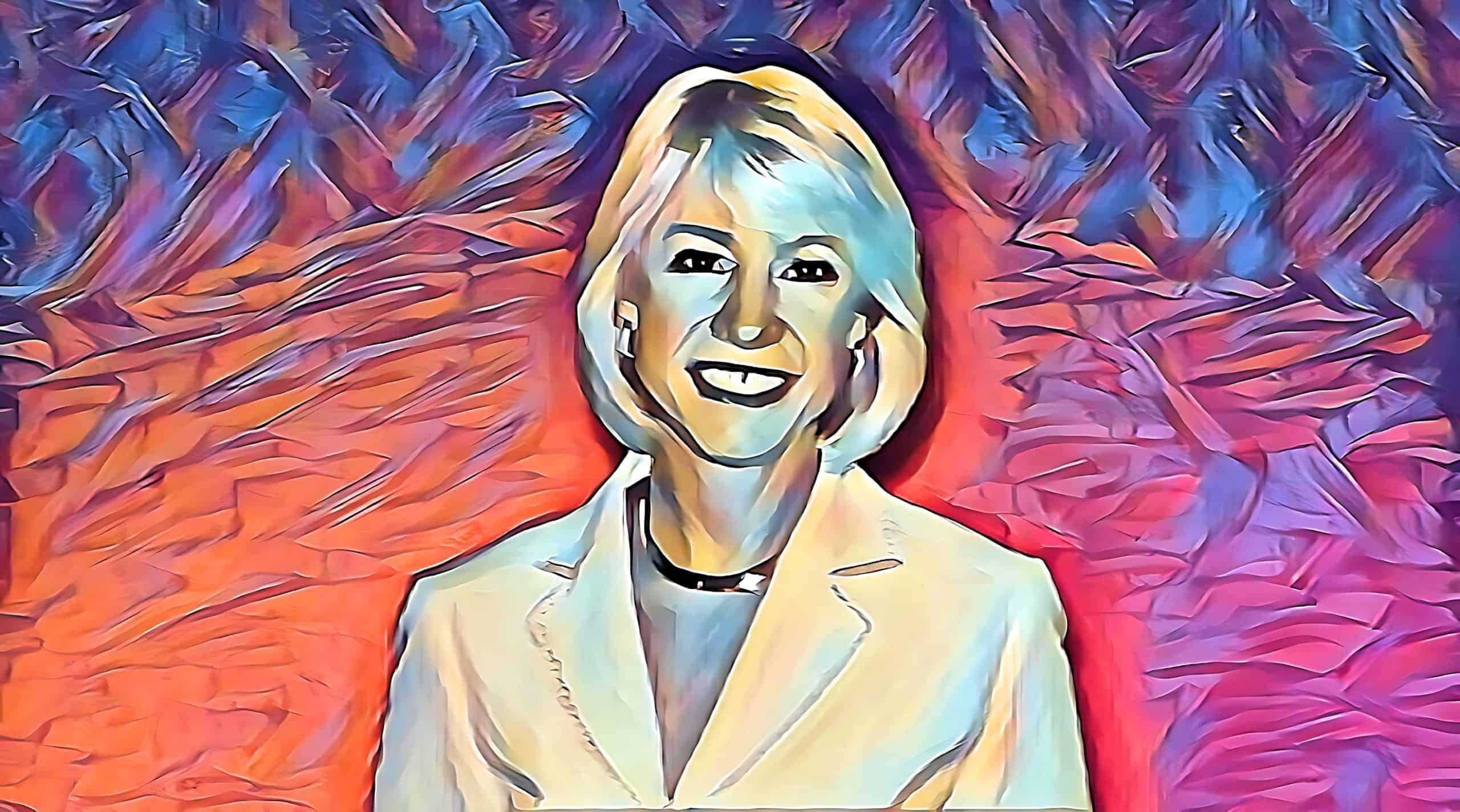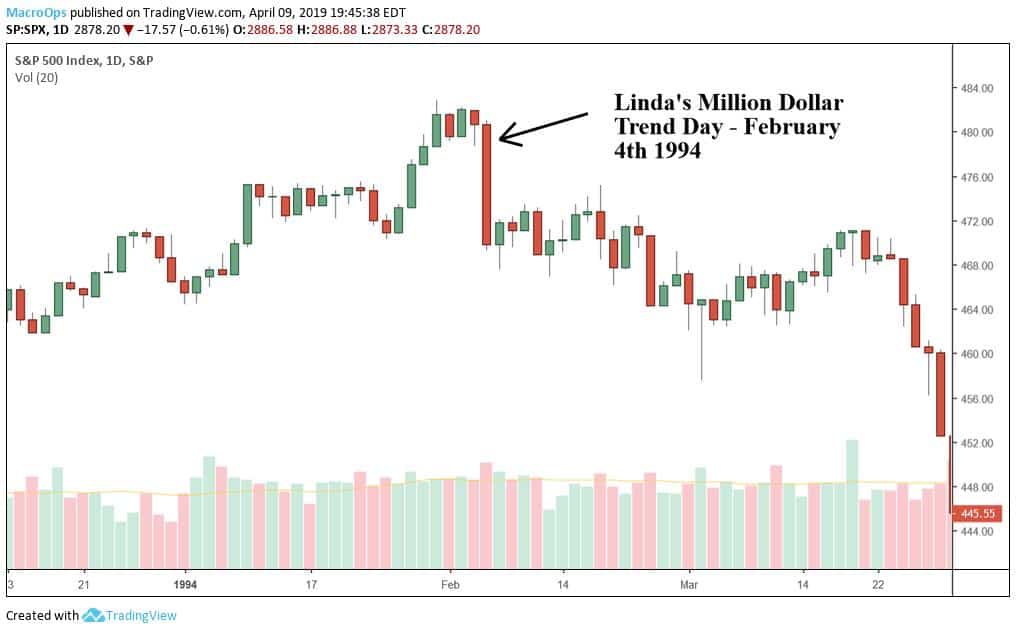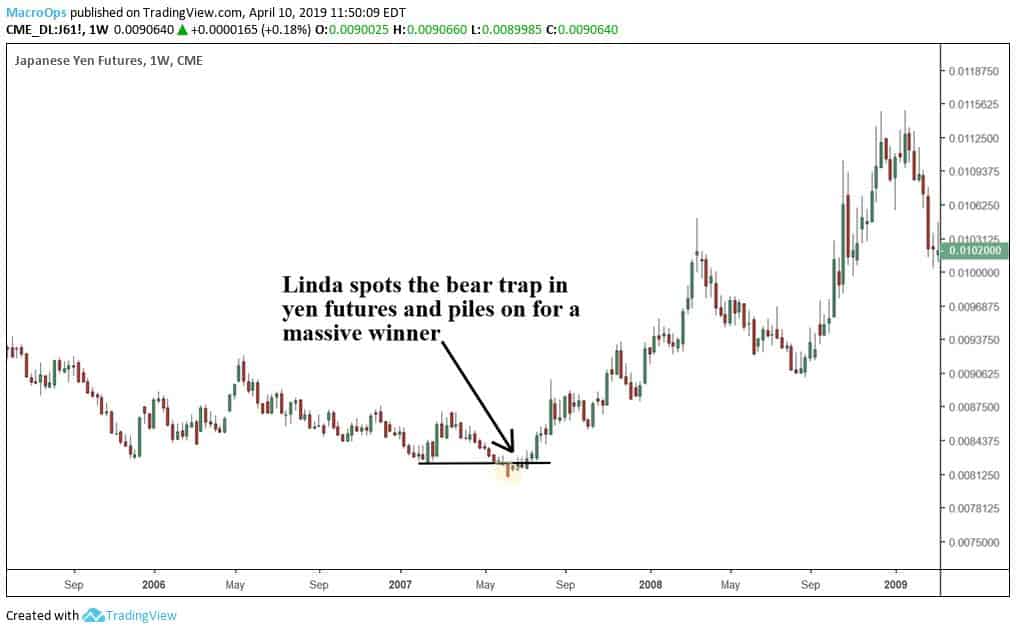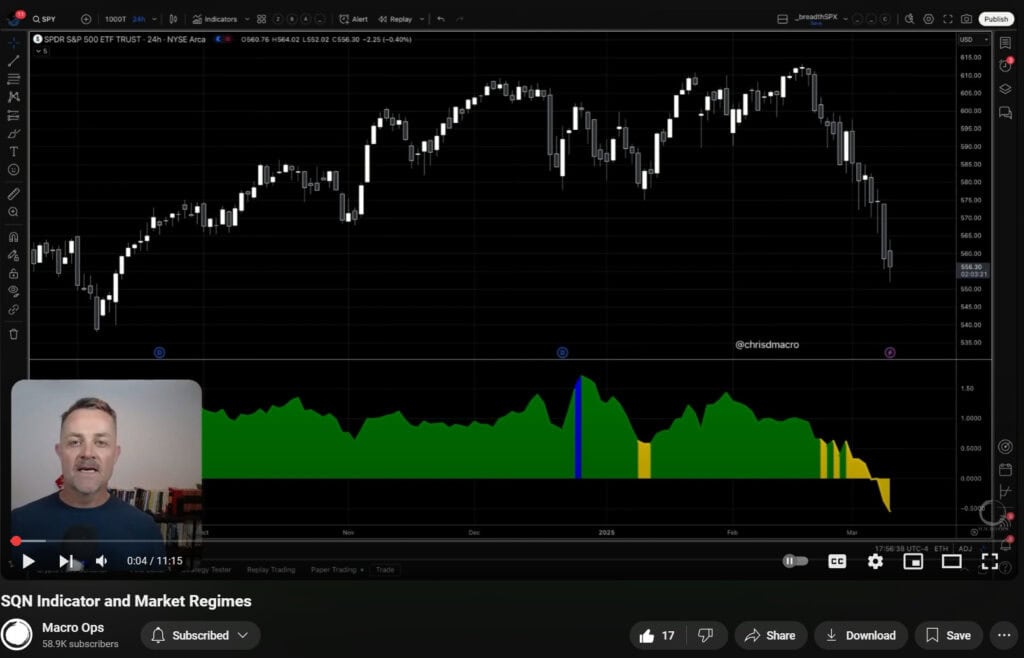In the following piece we’ll break down Linda Bradford Raschke’s trading strategy along with the tools she uses to consistently beat the stock market year after year.
I realize that I’m only human, and that I’ll always make mistakes. I just try to make them less frequently, recognize them faster, and correct them immediately!
We can thank Linda Bradford Raschke for that important bit of trading wisdom.
Only the very best can battle the markets over the long-haul and still come out on top. Linda Bradford Raschke is one of these traders. She’s been at the game for over three decades and still manages to clean up. You probably know the name. She was featured in Schwager’s The New Market Wizards book (hers was the best chapter in your author’s opinion).
If you haven’t already I highly recommend you go and check out her latest book Trading Sardines. It’s a fantastic read, full of humor and valuable trading wisdom from a decorated veteran of the game.
Linda’s traded from all sides of the business; as a market maker in the open outcry pits, as an individual trader for her own account, as well as a fund manager for institutional investors. She’s literally done it all.
In this piece, we’re going to explore Linda’s methods, habits, and practices. We’ll breakdown how she approaches markets and the tools she’s used to make a consistent killing over the years. Let’s jump in!
Linda Raschke’s 4 Trading Strategies
Linda segments her trading between four different strategies (she calls them profit centers). Each profit center has a different approach to the market so that she can diversify her revenue streams. Not all of them bring home the bacon each year, but she counts on at least one of them to make her nut for the year.
LBR Profit Center 1 — S&P Day Trading
S&P day trading is Linda’s bread and butter. 95% of this trading is in the E-mini S&P 500 futures contract as opposed to the other stock index futures like the Rut, DOW and NASDAQ. This was her original program and still to this day, her most consistent producer.
She stresses that successful day trading in the S&Ps requires contextual awareness. Do the odds favor a low to high day or a high to low day? Is it likely a trend day or a consolidation day? Getting this context right makes the trading day much easier.
Linda likes to fade the noisy fluctuations of the S&Ps as the market awaits a big economic report or FOMC release. On light volume days she likes to fade the tests of the intraday range.
But her biggest money maker is on high volume high vol trend days. Once Linda has the market by the tail she presses hard and rides her position into the close. There’s more on her big bet philosophy in the ensuing sections. Her “secret sauce” (like many of the other wizards) is knowing when to size up and “go for the jugular.”
LBR Profit Center 2 — Swing Trading
Her second profit center involves swing trading on the major futures contracts with a 1-3 day holding period. Losers get cut quickly.
For these swing trades, Linda generates entry signals based on 2-period ROCs and other momentum readings. Even with all the fancy computer equipment available, Linda still chooses to manually write down the indicator reading and closing prices for the 24+ futures markets that she tracks. Writing the data down every day helps keep her in tune with the market in a way that just following things on a screen can’t.
LBR Profit Center 3 — Daily and Weekly Classical Charting Trades
The third trading strategy generates profits using classical charting patterns with Peter Brandt style execution. Like Peter, her entry signals are discretionary but she does her best to quantify her process and patterns via ATRs, pivot points, and swing highs and lows.
To manage these trades she likes to use a trailing stop to see how much the market will give. If momentum begins to move against her, she will override the trailing stop and exit the market at the close.
She finds that her best trades come from daily swings turning up or down (false breakouts) rather than the breakouts of chart formations.
Over the course of her career, Linda has noticed that a particular market will give roughly 14-20 reasonable swings per year. Her goal is to just capture one great swing a month. If she does this then she’ll usually have a great year — provided she pulls back her aggressiveness when the market enters a period of low-volume churn.
LBR Profit Center 4 — The Everything Else Bucket (Special Situations)
Linda dips into this bucket during severe market dislocations. One of her favorite trades is to fade sentiment extremes with an option structure that allows her to take the other side of consensus fear/greed while keeping her risk capped. For bullish bets she prefers the long call spread, and for bearish bets she deploys the long put spread. This keeps her risk tightly defined in the incredibly volatile market conditions that accompany extremes in sentiment.
She’ll also take seasonality trades under this bucket. Seasonality trades are generated from patterns in the commodity markets. Check out this website for more info on commodity seasonality.
The defining characteristic of this bucket is that the opportunities are rare. And because of that they are not easily modeled.
Rare opportunities usually mean fatter edges because they can’t as easily be arbitraged away by a professional quant firm that uses immense computing power to search for patterns in reams of market data.
That’s the skinny on Linda’s trading setups. But setups are only a small part of what makes a trader of Linda’s caliber. In Trading Sardines she explains how successful trading requires much more than finding a good chart pattern. It’s about having a sound process, robust research methods, solid position sizing, good market reads and a healthy lifestyle away from the trading screen.
Linda Bradford Raschke’s Trading System
In trading, a good process leads to good profits.
Linda refers to her trading as a business. She uses terms like profit centers and costs. That’s a great way to frame it because one must approach trading with the same seriousness and discipline as one would running a business.
Successful businesses keep meticulous records so they know what’s working and what isn’t. Based on this feedback the leader will adjust fire and calibrate the process appropriately.
Linda does the same for her trading.
She monitors each of her four profit centers on a quarterly basis. Her performance will come from different programs each quarter depending on market conditions. If she finds that one profit center is consistently underperforming she’ll tweak her approach until it starts producing again.
One indicator she likes to look at is trade frequency. If trade frequency for one of her programs comes in way higher or way lower than normal she knows there’s likely an execution error going on. This usually means she’s overtrading, not getting rid of losers quickly enough, or trading while sleep deprived.
We follow a similar protocol here at Macro Ops. Each quarter we review our results and segment them by market and trade strategy type. We discard what’s not working and keep what does.
Another thing all successful businesses have in place is a crisis management plan. Linda has hers for trading. If an execution error occurs she immediately corrects course, no questions asked.
Linda talks about a time where she came into the open incredibly bullish on the S&P E-minis. But instead of going long she accidentally put on a large short. Instead of monkeying around and trying to find the perfect exit to limit her losses, she immediately cut the trade and went long.
“Correct mistakes immediately” has saved Linda millions of dollars over her trading career.
Linda Raschke On Models and System Building
Linda has the four core profit centers that work for her — but that doesn’t mean she stops refining her old edges and at the same time searching for new ones.
She is constantly scrutinizing and scouring around for new and improved approaches — the markets force you to continuously adapt or die.
Linda’s not a 100% mechanical trader but she tries to systematize as much as possible to take some mental burden off of herself so she can focus on the tape. Here’s her explaining this in Trading Sardines.
I was never a systems trader though I try to stay systematic. It is hard for me to give up the control I get with tape reading. I don’t want to give up control, period. I would like to believe my experience gives me an edge. But some people will only be able to make money following a system.
She also mentions that if you do use a system it has to be your system. This is in line with what we preach here at Macro Ops. You can’t succeed long-term blindly following somebody else’s approach. Here’s Linda again.
The problem is, it’s hard to muster the necessary confidence in a system unless you develop it yourself. Systems, even ones that make 100 trades a month, can go through brutal drawdown periods. And if the system isn’t your baby, you’ll abandon it with a loss instead of adhering to it long enough to recover a drawdown.
To vet system ideas Linda is a fan of manual backtesting.
My best work came from testing by hand. I could see where a signal worked and why. I could also look at the conditions where signals failed. When testing with a computer, too much data gets lumped together. This often cancels things out and it is easy to miss the subtle nuances that lead to learning. I’ve learned more by notating signals on charts, studying when signals don’t work, looking for secondary or confirming signs, and recording seas of data by hand. There is no way I could have created my numerous nuanced tactics by backtesting and doing computer runs.
Even though Linda is a discretionary trader she likes to build her trade ideas from the base of a model. Here’s why:
Most professional traders know things intuitively from experience. However, we are all subject to different cognitive biases. Models help us keep an open mind and guard against biases. They differ from mechanical systems but are an integral part of the trading process.
It’s possible to trade within the confines of a model or a framework but still allow enough flexibility so your trading is not 100% systematic. Using a model or framework to define trade ideas coupled with manual execution gives you the best of both worlds. The model keeps you from overtrading and the manual execution allows you to make adjustments depending on market conditions.
In Trading Sardines, Linda gives us some advice on how to start the modeling process. For her, it starts by asking some simple questions.
A modeling process starts out by asking simple questions. For example, what happens if you enter on a breakout of the first 15-minute bar after the opening? What is the distribution of how many ticks you can get in the next 15-minute bar? What happens if you enter on a breakout of the 15-minute bar going into the last hour and exit at MOC (market on close)? Is there a distribution pattern showing the most common time for highs and lows? The permutations are endless.
Once you discover the answers to these questions through backtesting and market research you can start to develop a real trading edge that will act as the foundation for your own profit center. Linda makes her models world-class by incorporating new information into each of her trades. This is a form of Bayesian inference — another concept we hound on again and again here at Macro Ops. Here’s Linda:
Another essential step is to layer on top of our multiple model tree a form of Bayesian process. Start with the prior models and probabilities and then continuously update them as new information unfolds. One data point at a time. To go one step further, we can even weigh these new pieces of information. And as the volume of information increases exponentially, you see how easy it is to fall down a rabbit hole.
In regards to model building Linda offers up some wisdom on how to design exit criteria. She’s a fan of time-based exits.
Much of my modeling uses time-based exits. Exits on the close or the next day’s close, Exit after one hour. Exit when Europe closes. Time-based exits are not dependent on the range or volatility condition, and they are robust.
Instead of exiting based on a predetermined price target, time exits allow you to realize the full strength of the signal. Here’s more on her exit philosophy from her interview in New Market Wizards.
I’m also afirmbeliever in predicting price direction, but not magnitude. I don’t set price targets. I get out when the market action tells me it’s time to get out, rather than based on any consideration of how far the price has gone. You have to be willing to take what the market gives you. If it doesn’t give you very much, you can’t hesitate to get out with a small profit.
Linda Raschke’s Position Sizing Strategy and the Big Bet
At Macro Ops we’re huge proponents of the Big Bet and there’s a reason for that. All of the trading greats talk about how “going for the jugular” when the stars align with your approach to the markets.
Linda says the same thing in different words.
When traders think about money management, they think about stops and trade management. But a big part of the equation is knowing when to go all in, increase the leverage and press your trading to the hilt. Load the boat. These opportunities have an increase in volume and volatility. There is no point in actively trading in a dull market. Let the market tip its hand and come to life first. And then if you are fortunate to be in the groove and know you’ve got a tiger by the tail, milk it for all it is worth. This is where the real money is made.
It’s possible to simply “get by” in trading by having an okay edge and proper risk control. But if you want to achieve market wizard status you have to know when to up size and bet big.
Linda’s first ever 7-figure day in the market came from utilizing the big bet strategy on the S&P E-mini contract.
There is no more glorious feeling in the world than capturing a huge trend day. My first seven-digit day came from a short position in the S&Ps. The market was overbought, the sentiment readings showed too much bullishness, the 2-period rate of change was poised to flip down and my models lined up like a rare planetary alignment.
I had come into the day with a short side bias. When the market started selling off the opening, I added in a big way and held until the close.
I want to stress her planetary alignment comment here. Because this moment is similar to what Druck talks about when he says to go for the “whole hog” or when Warren Buffett mentions “swinging hard at the fat pitch.”
All market opportunities are not created equal which is why position size must vary depending on the expected value of the trade: EV = (Probability of Winning) x (Amount Won if Correct) – (Probability of Losing) x (Amount Lost If Wrong)
When trading a diverse set of markets like Linda it’s paramount to standardize the dollar risk of each contract so each trade risks a similar dollar amount. By not standardizing the risk between markets, the most volatile market will dominate the p&l.
Linda uses the average dollar daily range for each contract she trades in order to get all of her positions sized correctly.
Each quarter, we calculated the average daily dollar range per market. If gold had a 20-dollar average daily range over the previous 30 days, this translated into a $2,000 average daily dollar range. If the S&P e-minis had a 14-point average daily range, this is a $700 average daily dollar range. Gold sizing might be 4 contracts per million. If we had $100 million of AUM, it mean that 1 unit of gold equaled 400 contracts. In the S&P e-minis, 1 unit might be 10 contracts per million or 1000 contracts.
This is otherwise known as volatility-weighted position sizing. This ensures a trader risks similar amounts on each trade. Lower volatility instruments will need more contracts and higher volatility instruments mean fewer contracts. By sizing this way, fluctuations in highly volatile markets will equal the fluctuations in quieter markets.
In markets, there’s a time to play aggressive offense (and place the big bet), and then there’s a time to play aggressive defense. When positions move against you, Linda suggests to taking off size until you can think clearly again.
Whenever you have your back up against the wall, you have to get smaller. Reduce your size to the level where you can start trading again, because in these types of situations when there is uncertainty or unprecedented volatility, there is lots of money to be made. But you can’t do it if you are frozen or stressed, so figure out the level where you can function and trade freely again.
Taking size off when things go south will preserve mental capital and allow you to get ready to pile on again when general conditions favor your bias.
Linda Bradford Raschke On Market Dynamics
It’s not the actual news that’s important — it’s the market’s reaction to that news that is most important to a trader.
Linda talks about this concept and gives guidance on how to best trade news-driven moves.
If positive economic news is released and the market sells off on that news, this could also be perceived as an aberration. It is a divergence from what would normally be expected. But this, too, is the market’s way of imparting powerful information. In this case, it may be that there are no buyers left, or that the news has been long discounted.
Trade in the direction of the aberration. The market is never too high to buy or too low to sell.
Trading mastery requires a thorough understanding of the boom/bust process that plays out over and over again in public markets. Linda has studied the underlying dynamics of the boom/bust process to give her the confidence to trade bubbles when they are about to pop.
There was a study done on price behavior when the field of behavioral finance was just coming on the scene. It simulated trading with groups of individuals who were not traders. The price of the market would always rise first. It kept inching higher until everyone had bid and there was nobody left to buy. At that point, it broke sharply with no support underneath.
To this day, this is one of the main reasons markets sell off—there is nobody left to buy.
That’s why at Macro Ops we are such huge fans of sentiment indicators. Sentiment indicators tell us when there is “no one left to buy.” Periods of extreme optimism set the stage for gut-wrenching selloffs. Linda exploits this same edge in her profit center 4 through the use of call spreads or put spreads.
The Trifecta Approach: Combining Fundamentals and Technicals
The best traders in the game pull data and information from numerous sources to construct a trading thesis. Linda uses the “Marcus Trifecta” approach in her trading by first finding fundamental market imbalances and then entering the market via technical analysis cues.
She made tons of money trading the yen using this multi-faceted approach. Here’s an excerpt from Trading Sardines which describes the trade in more detail.
The “carry trade” was a popular strategy from 2002-2007. Investors borrowed money in yen where interest rates were low and invested it in higher-yielding currencies. It was a crowded trade, meaning too many people were in this same position. What was going to happen when people needed to unwind?
I trade by technicals since I have not yet had much luck using fundamentals. But I am aware when there is a market imbalance implying a crowded trade. The yen was a ripe situation. It has left a bear trap or false downside breakout on the weekly charts. I tried twice to put on a position, both times unsuccessful. The third time I knew I got it right. It was our signal to load up. I don’t mind trying a few times if there is a basis for a position but the timing is off. The real key is to make it pay and use maximum leverage when the trade starts working. I told Judd to keep buying yen, and the ensuing rally made our year. The yen went straight up for the next five years as global interest rates came crashing down.
On Trading Lifestyle
Grinding an initial capital stake into millions of dollars takes time. Fortunes aren’t made overnight in the trading business. The big money is made by finishing the marathon, not the sprint.
Linda makes this clear and lays out many lifestyle strategies that maximize your chances of making a real fortune from trading the markets.
She used the following three things over her long career to keep her mind and body fresh and ready to battle the markets day in and day out.
- Gratitude practice
- Physical fitness
- Time off
The markets are volatile beasts which means they will send your emotional brain into a whirlwind. In order to combat the push/pull of these emotions, Linda uses a gratitude practice to keep her grounded when things go wrong.
Gratitude is a key ingredient of success. It means that even when bad things are happening, you always have something to focus on. Just like pilots have a gauge to make sure they can still tell which way is up, gratitude keeps me from ever feeling upside down. When you are trading the markets, you have to have a separate source of happiness —- to know that there are still wonderful things all around, most of which do not require money. It is easier to take risks when you remove your personal happiness and well-being from the equation.
Gratitude leads to optimism, and a positive attitude is 90% of the game.
Linda was extremely active in the gym and even competed as a bodybuilder! The discipline required for her to compete in bodybuilding carried over into her trading program.
Trading and physical training have a lot in common. Every successful training routine requires the following:
- A sound methodology
- Consistent execution of that methodology through the use of daily rituals
- Records of progress
- Positive thinking and optimism
These are the exact same things needed to succeed in the trading grind! So if you aren’t already, get in the gym!
Finally, Linda recommends taking time away from the trading screens to refresh and recharge. A hobby helps to relieve stress. For her, this was horseback riding.
LBR has the whole package of a legendary trader — a burning desire to win, emotional fortitude to withstand the ups and downs of a trading career and the ability to “go for the jugular” when the market required it.
I want to end this piece with her advice on how to find success as a new trader.
Understand that learning the markets can take years. Immerse yourself in the world of trading and give up everything else. Get as close to other successful traders as you can. Consider working for one for free. Start by finding a niche and specializing. Pick one market or pattern and learn it inside out before expanding your focus.
Finally, remember that a trader is someone who does his own work, has his own game plan, and makes his own decisions. Only by acting and thinking independently can a trader hope to know when a trade isn’t working out. If you ever find yourself tempted to seek out someone else’s opinion on a trade, that’s usually a sure sign that you should get out of your position.
Well said Linda… Now time to get to work!
If you liked this article, you will love Lessons From The Trading Greats Volume 1 which has more insight from the world’s best traders. Click here for a free copy!













